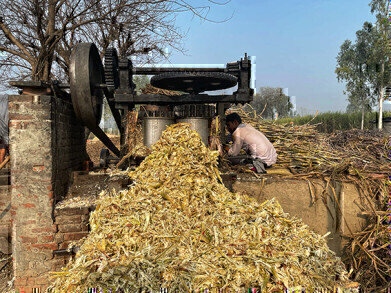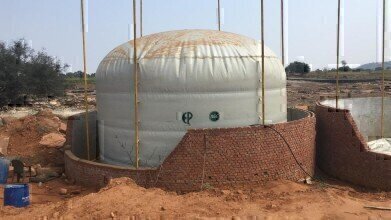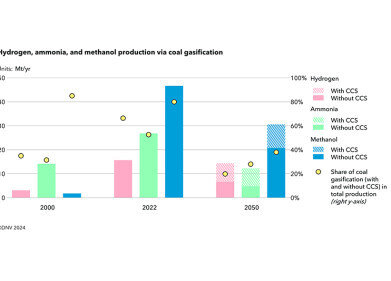-
 Bagasse processing to biomethane and biohydrogen
Bagasse processing to biomethane and biohydrogen -
 Coconut husks and palm fronds can be converted to biohydrogen
Coconut husks and palm fronds can be converted to biohydrogen -
 Bio hythane storage copyright Biezel Green Energy
Bio hythane storage copyright Biezel Green Energy
Green Energy
From biomass to biofuel with Biezel Green Energy’s TAD Technology
Jul 23 2021
Author credit: Stephen B. Harrison and Allegra Cresswell-Turner, sbh4 consulting
Biezel Green Energy is a renewable energy company founded in 2018 by Dr Preetam Singh in Uttar Pradesh, India. He works alongside co-founder, Dr Konda Shiva and is mentored by Professor John B. Goodenough who is the inventor of current generation of rechargeable Li-ion batteries and was awarded Nobel prize in chemistry 2019 for his work in that field.
The company has developed a technology that is able to fractionate biomass into solid and gaseous renewable fuels. Their innovative TAD (Thermally accelerated Anaerobic Digestion) system converts organic waste into high energy fuels, achieving up to 50% Biomass to fuel conversion efficiency.
Biofuels from agricultural wastes
“TAD reactors can process any kind of biomass and biomass wastes”, says Dr Singh. “However, green ligneous wastes, such as banana leaves, rubber plantation waste, coconut, palm fronds and coconut husks are preferred.” Rice husks, wheat straw, sugar cane, flowers and ligneous paper waste are also highly suitable. These feedstocks are ideal because the lignin has high hydrogen to carbon ratio in the natural molecules and responds well to the chemical processes and proprietary catalyst that are used in the TAD reactor.
Fresh green feedstocks with a moisture content of around 20-25% are ideal for the process because hydrogen contained in the water molecules is converted to hydrogen gas by the catalysts present in the reactor. The hydrogen yield of wet crops therefore exceeds that of dried feedstock.
Rural economies in tropical and sub-tropical countries where these crops are grown, would be ideal target locations for this process. The flexibility of the TAD to process a broad range of feedstocks means that the seasonal availability of various crops throughout the year can ensure operation for up to nine months out of 12. During the remaining three months, the process can be fed with food scraps or crop wastes that have been stored from the growing and harvesting seasons. According to Singh: “we propose stubble management to yield usable energy vectors instead of stubble burning which simply releases carbon dioxide to the air.”
Carbon-neutrality can be achieved in one cropping season because the plants capture carbon dioxide from the air during their growth. When the fuels that are derived from the biomass are subsequently burned to release carbon dioxide, there is no long-term increase in the carbon dioxide in the air.
A range of green energy vectors
The Biezel Green Energy TAD reactor converts biomass wastes that do not have any significant commercial importance, into carbon-neutral fuels with unprecedented efficiency. The main products from their process are Bio-Hydrogen, Bio-CNG (or RLNG) and Bio-coal.
Bio-Hydrogen can be used for electricity generation, fuel cells, fuel for IC engines, aviation, gas furnaces, glass making and welding. Additionally, it can be used as a chemical for hydrogenation of vegetable oils, a chemical for ammonia and urea fertilizer production or liquid fuels desulphurisation in oil refineries.
Bio-CNG can be used for fuel for gas fired power plants, as a transportation fuel in IC engines, for domestic heating and cooking or gas burners in industrial process heating.
Lastly, the graphitic oxide (C6O) Bio-coal can be used as fuel for thermal power plants. It is also ideal for activated carbon production because of its high surface area. Since it is smokeless, it can be used for indoor cooking without having any harmful effects from pollutant gases. It is also suitable for heavy heating in industries that require indirect heating and can be used in the Metallurgical industry as a coke substitute for iron ore reduction. It can even be applied in the cosmetics industry.
Environmental, social, and economic benefits for rural tropical regions
There are socio-economic advantages that result from the TAD process, for example, farmers can acquire additional income for agricultural waste. It can also generate local jobs around the procurement and transportation of raw material, as well as plant operation.
Furthermore, it generates clean energy, thus reducing pollution and the reliance on fossil fuel-based energy systems. It can also reduce the risk of deforestation because communities no longer need to search for wood to fire their cooking and heating requirements. Trees can be left to grow to maturity and remove carbon dioxide from the air as part of the natural carbon cycle.
Biezel is currently aiming towards building a full-scale plant by December 2021 near Varanasi. With a modular scheme based on 25 reactors, it will produce one tonne of hydrogen per day and cost around 3.5 million US dollars. Beyond this plant, Dr Singh and the team at Biezel Green Energy are actively seeking additional business partners to achieve their scale up objectives in India and overseas.
Events
May 05 2024 Seville, Spain
May 13 2024 Munich, Germany
May 23 2024 Beijing, China
May 23 2024 Beijing, China
Jun 10 2024 Algiers, Algeria













